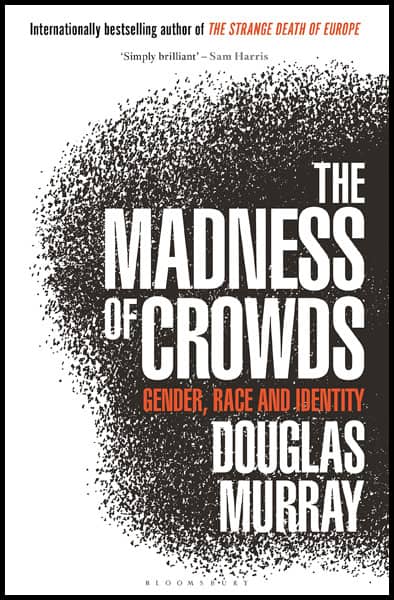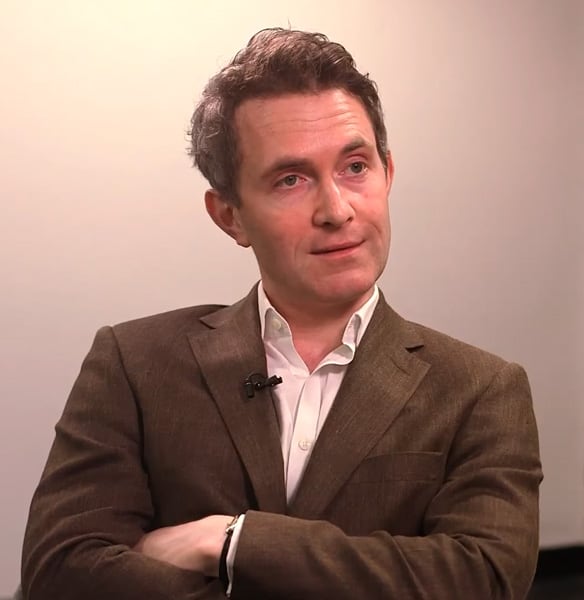The Madness of Crowds
Jared Taylor, American Renaissance, October 21, 2019

Douglas Murray, The Madness of Crowds: Gender, Race and Identity, Bloomsbury Continuum, 2019, 280 pp., $28.00.
Douglas Murray is a British author who writes incisively about “progressive” absurdities. His 2017 book, The Strange Death of Europe described Western Europe’s capitulation in the face of “the great replacement.” Strangely, Mr. Murray didn’t seem to think the United States faced a similar death.
In this book, his focus is slightly different — the dangerous things the Left insists we believe about race, the sexes, homosexuals, and transsexuals — and this time he lets fly at Yanks with all the passion we deserve. Mr. Murray’s new book is called The Madness of Crowds, and it is certainly about madness but not about crowds. It is more about bullies who wield so much media and political power that they can torment and silence crowds of generally sensible people.

And the bullies truly are mad. Their madness is so grotesque it is easy to criticize — Mr. Murray does so cleverly — but they are so powerful that even he does not appear able to write with complete honesty.
Universities
Mr. Murray says many worthwhile things about the different kinds of contemporary madness, but let us first look at some of his general observations: “Equality is the stated objective of every Western government, the stated aim of all mainstream civic organizations and the aspiration of anybody wishing to find a place in polite society.” He notes, though, that we don’t even know “what equality means or whether it even exists,” adding that some on the Left are so ridiculous as to call for equality of outcome, but that even the “conservative” goal of “equal opportunity” is impossible on any but a very small scale.
Much of the madness originated in American universities, where 18 percent of professors in the social sciences happily admit they are Marxists. One of the great disappointments for last century’s Marxists was that workers didn’t want to be revolutionaries — they wanted to be bourgeois, just like the class they were supposed to destroy. Marxists then found more worthy victims: anyone who was not a heterosexual white man.
Defining and motivating victims required “deconstructing” virtually everything we had always taken for granted. As Mr. Murray notes, “To ‘deconstruct’ something is as significant in academia as ‘constructing’ things is in the rest of society.” The purpose is to reveal the wicked structure of Western society, and to show how gloriously oppressed, marginalized, and dehumanized are the new revolutionaries: women, “people of color,” homosexuals, immigrants, fat people, and whoever else puts up a din. As Mr. Murray notes, “The person who professes himself the most aggrieved gets the most attention,” and if someone can claim several kinds of oppressions — say, a one-legged black lesbian — he can wear the coveted badge of “intersectionality.”
This is what queer studies, black studies, women’s studies, etc. are about: uncovering “structures of oppression” and elevating the oppressed. “Whiteness studies” is the only exception; its purpose is to blame and scorn whites.
Mr. Murray adds that lefties assume that if all these “marginalized” groups “unite against the common enemy of the people at the top of the pyramid who allegedly hold the power, then something good will happen.” But what? Nobody knows. The struggle against evil -isms and -phobias seems only to uncover yet more. No one is ever cured of these ills. As Gregory Hood notes, liberalism is a church without salvation. The worst fanatics throw up their hands and say there can’t be progress until capitalism is destroyed — which brings us back to Marx and Engels.
And also back to Mr. Murray, who wonders what drives the egalitarian Left:
[N]othing about the intersectional, social justice movement suggests that it is really interested in solving any of the problems that it claims to be interested in. The first clue lies in the partial, biased, unrepresentative and unfair depiction of our own societies. Few people think that a country cannot be improved on, but to present it as riddled with bigotry, hatred and oppression is at best a partial and at worst a nakedly hostile prism though which to view society. It is an analysis expressed not in the manner of a critic hoping to improve, but as an enemy eager to destroy.
Well said. Much of what goes on at college is not learning but a malign form of political activism. The black Yale students who have detected “entrenched white supremacy” on a campus that pets and pampers them will never find relief until there are no more whites left. If all men are shoring up the “patriarchy,” the only solution is to abolish them. The whole point seems to be to make people doubt and hate their own societies. And, as Mr. Murray points out, this screaming about injustice and oppression goes on in countries that have done more than any in history to try to be “fair.” Malcontents don’t move to Ghana or Ecuador.
Much as some blacks and man-haters might like it, white men aren’t going to commit mass suicide, and at least a few will have to be kept around to fix jet engines, put out forest fires, and replace sewer lines. Mr. Murray does not seem to realize that the goal of all this yelling is power: to get more of the wealth that the despised white man still manages to produce.
Mr. Murray notes another characteristic of the Left: “the strange retributive instinct of our time towards the past which suggests that we know ourselves to be better than people in history because we know how they behaved and we know that we would have behaved better.” This is why it is so common to heap abuse on everyone from Columbus to the Founding Fathers to Robert E. Lee.

(Credit Image: © Michael Nigro/Pacific Press via ZUMA Wire)
But the iniquitous “past” keeps catching up with the present. Standards of morality change so quickly that it is almost impossible not to violate what Mr. Murray calls “the swiftly moving dogmas of the age.” Until 1973, homosexuality was listed as a mental disorder by the American Psychiatric Association, and in 2003, there were anti-sodomy laws in 14 American states. And yet, in 2018, MSNBC host Joy Reid had to grovel because 10 years earlier she had criticized the idea of gay marriage — at a time when nearly everyone criticized it. In 2013, British MP Nicky Morgan voted against legalizing same-sex marriage, but just two years later, she was telling the BBC that if a student were caught saying homosexuality was evil it might be right to report him to the police.
Anyone who doesn’t keep up must be crushed. The most famous living scientist in the world, James Watson, became a non-person for saying a few unfashionable things about blacks. Nobel Prize winner Tim Hunt’s career nearly ended when he joked that women can be trouble in the lab because they cause romantic problems and cry when you criticize them.
Mr. Murray also notes how Google rubs our noses in orthodoxy. In one famous example, if you ask Google for “American inventors,” eight of the top 10 are black. When I searched for images of “European art,” six of the first 18 were of black people. The top three images for “white men” were black people, even though “black men” gives you pages of black men. “White family” gave me black people in positions 2, 4, 5, 6, and 7, and quite a few same-sex couples. “Asian” or “black” family gives you what you expect. As Mr. Murray notes, “anyone who might be searching for heteronormative or Caucasian couples; these people would obviously already be a problem and must be refused and frustrated . . . . They must be given a giant, tech-sized ‘F- you’.”
Mr. Murray notes that the Left issues diktats on every unsettled or controversial issue, and then excommunicates dissenters. He marvels at “the spurious certainty with which an unbelievably unclear issue is presented as though it was the clearest and best understood thing imaginable.” The truth doesn’t matter, with the result that “we have begun trying to reorder our societies not in line with facts we know from science but based on political falsehoods pushed by activists in the social sciences.”
Trans people
There are many examples of this reordering, but one Mr. Murray concentrates on is the sudden preoccupation with “trans” people. He writes: “There is no other issue (let alone one affecting relatively few people) that has so swiftly reached the stage whereby whole pages of newspapers are devoted to its latest developments, and where there is a never-ending demand not just to change the language but to make up the science around it.”
Until very recently, there was general agreement that anyone who believed he was the wrong sex was crazy, but Mr. Murray notes that “trans has become something close to a dogma in record time.” He adds that we have no idea what causes so-called “gender dysphoria.” He suspects that the idea of a sex change may be especially appealing to effeminate homosexuals who cannot attract the butch-type men with whom they want to have sex. They may think that if they turn themselves into women they can finally bed desirable, masculine men.
Mr. Murray suggests that the attraction of “trans” may even be a perversion, in which people get sexual pleasure from imagining they are in the body of the other sex, but if the trans craze is only about kinky fantasies, we shouldn’t have to learn new pronouns or change public restrooms or tell children they are whatever sex they think they are. Therefore, the campaign is on to insist that wanting a sex change is inherent and irresistible, even though no one has yet found anything genetically or physically distinct about people who want to make the switch.

An activist attends a rally against the transgender military ban. (Credit Image: © Nancy Kaszerman/ZUMA Wire)
Mr. Murray recognizes that some men genuinely seem to believe they are trapped in the wrong body and think their penis is a hateful appendage, but he asks, “How could this urge to remove a part of one’s body be distinguished from a patient telling a doctor that they believed themselves to be Admiral Nelson and in pursuit of this belief wanted their right arm removed?” And yet, he is moved by British author James Morris — now known as Jan — who wrote two years after his pioneering sex change operation in 1972 that if he still had a penis, “nothing would keep me from my goal . . . I would search the earth for surgeons, I would bribe barbers and abortionists, I would take a knife and do it myself, without fear, without qualms, without a second thought.”
Jan Morris is now 93; does he still believe that? Perhaps. He sacrificed a lot. Before the sex change, he was a married man with four children. He had to divorce his wife after the operation, because Britain didn’t recognize same-sex marriage, but remarried the same woman when lesbian marriage became legal.
Mr. Murray reports that about 80 percent of the children who have “gender dysphoria” get over it in puberty, and that most of them will grow up to be conventional homosexuals or lesbians. And yet, it is now common to take young people seriously when they claim to want a sex change, and there are counselors and institutions to guide them on their way.
The trouble is, after the operation, there is no going back. Mr. Murray predicts that future generations will be shocked that we let teenagers go under the knife more or less on their own volition. He suspects we are in a media-induced trans fad, but to say so is to commit the great taboo that homosexuals police so carefully: We must never doubt them when they say that homosexuality (or any off-beat eroticism) is an immutable matter of hardware; environment never changes anyone’s mind.
In the meantime, “trans” has piquant moments. A former man, now known as Karen White, was jailed for raping a woman. He was “transitioning,” and asked to be put in a women’s prison. His “transition,” however, had not yet reached the amputation stage, and he sexually assaulted four woman inmates. Where does one lock up such a creature?
“Trans” annoys some feminists. It gets their backs up when ex-men tell them how to be a woman. Mr. Murray writes of their understandable complaints:
They had suffered through period pains, batting off sexual advances from male strangers, gone through childbirth, had stared menopause in the face and now had the delights of hormone replacement therapy. . . . [They were] damned if they were now going to be lectured at or called names by ‘dicks in chicks’ clothing’ and ‘a bunch of bed-wetters in bad wigs.’
This, of course, turned out to be “hatred of the trans community,” and at least one lady journalist who wrote in this vein saw her career dry up.
Not even the great names in feminism are safe. In 1999, Germaine Greer wrote a 10-page essay, explaining that someone born a man can’t be a woman. In 2015, she was invited to give a talk at Cardiff University in Wales, but students rose up in wrath over her “misogynistic views towards trans women,” so she stayed home. Miss Greer probably never imagined she would be called a misogynist.
But if sex can be chosen, why not race? The feminist journal Hypatia argued that since we praised Caitlin Jenner’s decision to become a woman, we should praise Rachel Dolezal’s decision to become black. Blacks turned on Hypatia with such fury the editor resigned, and all the directors were replaced. Blacks laid down the law: Someone who grew up white can never be black. Why did that argument work for them but not for people who think men can’t become women?
Homosexuals
Mr. Murray is homosexual and keeps a critical eye on his “community.” As noted, the community is adamant that erotic orientation is built in and that no one is ever “recruited.” Mr. Murray writes that the science about this is murky — as I discovered myself when I researched the causes and consequences of homosexuality. It is nearly impossible to find anything that is not pure ax-grinding: The “research” is either Christian and biased or pro-gay and biased. Nobody seems simply to want to know what’s what. As Mr. Murray notes, “Scientists are unable or unwilling to answer questions over the origins of homosexuality.”
The “it’s hardware” crowd feels betrayed by anyone who dabbles in “the community” and then defects. “Gay men who went straight often received more resentment from their circle of friends than a straight man who came out as gay,” Mr. Murray explains. He says there is a fair amount of defection, but the media ignore it in deference to the “hardware” argument.
Mr. Murray points out that even “the community” can’t agree whether homosexuals want to be treated just like everyone else — except that they like sex with men — or whether they are “queer” across-the-board:
Whereas gays may just want to be accepted . . . , queers want to be recognized as fundamentally different to everyone else and to use that difference to tear down the kind of order that gays are working to get into. . . . Those who push the ‘queer’ view of gay do tend to present it as being a full-time occupation. Those who are gay tend not to like them.
On “gay pride” days, the tame homosexuals carrying the banners always worry what the leather-chaps crowd and the boys in dog collars on all fours are getting up to at the back of the parade.
There were battling interpretations when Peter Thiel told the 2016 Republican National Convention he was proud to be gay. Liberals swooned with joy, but America’s number-one homosexual magazine, Advocate, poured scorn on the idea that this was a breakthrough: “Thiel is an example of a man who has sex with other men, but not a gay man. Because he does not embrace the struggle of people to embrace their distinctive identity.” Apparently only troublemakers are truly “gay.”

Peter Thiel addresses the Republican National Convention, July 21, 2016 in Cleveland, Ohio. (Credit Image: © Richard Ellis/ZUMA Wire)
One problem for the “we’re normal” lads is that if they are just like everyone else, shouldn’t they be held to the same standards? Mr. Murray notes that “among the first [homosexual] couples to get married in the US was one who immediately admitted to an interviewer that they were in an open relationship.” Homosexuals “appear to want to be precisely equal but with a little gay bonus.”
Mr. Murray says it is foolish to lump every LBGT and Q together as if they had a common identity:
Gay men and gay women have almost nothing in common. . . . Gay men often characterize lesbians as dowdy and boring. . . . [B]isexuals continue to be viewed not so much as part of the same ‘community’ as gays as some kind of betrayal from within its midst. Gay men tend to believe that men who claim to be ‘Bi’ are in fact gays in some form of denial (‘Bi now, gay later.’) . . . There is tremendous dispute over whether the T’s are the same thing as everybody else or an insult to them. Still nobody is any the wiser about where any or all of this comes from.
And Mr. Murray notes the curious way homosexuality, once reviled or ignored, pops up in the media: “There are days when you wonder how heterosexuals feel about the growing insistence with which gay stories are crow-barred into any and all areas of the news.” The media are “perhaps making up for lost time or perhaps just rubbing things in the faces of those not yet up to speed with the changed mores of the age.” Surely, it’s the latter.
Women
Mr. Murray spends many pages making the obvious point that women go to great lengths to make themselves as alluring as possible but get angry when the wrong men notice. “[A] woman must be allowed to as sexy and sexual as she pleases, but that does not mean she can be sexualized,” he writes. “Sexy, but not sexualized. It is an impossible demand.”
He also notes that feminism, which used to be about “empowering” women, is now about despising men. Mr. Murray says it’s about time we dusted off the word “misandry,” which means man hating. This is especially true in an era in which someone like Donald Trump, who unabashedly enjoys the favors of pretty women, is called a “misogynist.” What else but hatred is it when “all men are trash” trends on social media, and people seem to think the phrase “toxic masculinity” actually means something. Is there “toxic femininity?” If not, why not?
Mr. Murray asks: If “toxic masculinity” has to do with competitiveness, “might a male athlete be allowed to use his competitive instincts on the racetrack? If so, how can he be helped to ensure that off the track he is as docile as possible?” And what is “male privilege?” Are high male suicide rates and high death rates from dangerous professions part of it? Mr. Murray argues that all this contempt is “a move less intended to improve men than to neuter them, to turn any and all of their virtues around on them and turn them instead into self-doubting self-loathing objects of pity.” Today, even a men’s magazine, GQ, can write such nonsense as, “For the first time in history, we’ve all been called to account for the sins of the patriarchy.”
Mr. Murray explains that the current theory is that “Women are exactly the same as men — as capable, as able, as suited to the same array of tasks. Also better.” But this leaves out the essential difference: Women can become mothers. Feminists have never figured out how that fits into being just like men, but if there are any doubts about motherhood, a woman can just skip it. CNBC wrote an article called “You can save half a million dollars if you don’t have kids.” The author noted breezily, “Your friends may tell you having kids made them happier. They’re probably lying.”
It’s astonishing enough that anyone manages to pretend there are no race differences, but sex differences are about as widely known as knowledge can be. A society that thinks women’s sexual appetites are the same as men’s — and puts women in submarines and firehouses — is prepared to believe and do just about anything. As Mr. Murray points out many times, homosexuals have shouted down anyone who doesn’t agree that erotic orientation is “hardware.” And yet, when it comes to the sexes, “the argument became entrenched that this most fundamental hardware issue of all was in fact a matter of software.” He continues: “we are being not just asked but expected to radically alter our lives and societies on the basis of claims that our instincts all tell us cannot possibly be true.”
This is very fine as far as it goes, but how, exactly, are we supposed to stop altering our societies? Quit hounding women into jobs? Assume they will be only a tiny minority in science and tech? Fire all firewomen? Stop whooping up every woman who gets into congress or the corner office? Take away their vote? Mr. Murray has no answers. He ducks out as soon as the going gets rough.
Race
And, of course, he ducks out even sooner on race — though after having said a few sensible things. For example: “A lot can be surmised about the cultural expectations of publishers when they sign up authors whose first book is a memoir.” That was Ta-Nehisi Coates and The Beautiful Struggle. Mr. Coates has now published two memoirs before age 40, which must be some kind of record, although Barack Obama comes in a close second with Dreams of My Father and The Audacity of Hope.
Mr. Murray does not get past “conservative” platitudes on race, but he phrases them nicely: “At the very moment when the issue of race might at long last have been put to rest, they have decided once again to make it the most important issue of all. . . . [A]fter the situation appears at the very least to be better than it ever was, it is presented as though it has never been worse.”
He adds: “Just as women can be told that we are in a culture so rife with rape that it can fairly be described as a ‘rape culture,’ so too people behave as though they live in a society teetering on the edge of Hitlerism.” And, alas, “rather than managing to ignore the issue of race we are going to have to spend the foreseeable future constantly focused on it.”
Mr. Murray also notices that many blacks, just like the most predatory feminists, are not even trying to be constructive. They accuse whites (with the help of white ethnomasocists) of color-blind racism, unconscious racism and, no matter how much they want to be “allies,” of contributing to the “structure of white hegemony” simply by breathing. An idea that started in universities has now been loosed upon society: Everything has been poisoned by implicit and explicit racism, so everything must be either turned upside down or destroyed.
And just when Mr. Murray thought we were all going to hold hands and sing Kumbaya!
Despite his many insights into other aspects of the madness of crowds, Mr. Murray makes one fundamental mistake about race: He doesn’t understand that formal equality and even race preferences are never enough. A population with an average IQ of 85 can’t do the same things as one with an average of 100. That is why blacks and loony whites had to invent “systemic racism,” and blame all whites everywhere and always for black failure. There is only one way out of this trap, and Mr. Murray probably knows it.
But that, according to Mr. Murray, is “a question we do not ask because we have already decided what the answers cannot be. The question is whether race is a hardware or a software issue. . . . Research into IQ and genetics is, among much competition, probably the most dangerous and cordoned-off subject of all.”
There’s more:
[T]he Bell Curve controversy will never be fought on the basis of the facts. These are too uncomfortable to be allowed to roam freely in the intellectual air. And so the fall-back position for refusing to engage with the evidence on IQ differentials is to say that even if the facts are there, and even if they are very clear, it is morally suspicious to want to look into them and that they in any case present us with ethical and moral problems so vast and complex that there is nothing at all that can be done with them. . . . Because the knowledge could be used by bad people the enquiry cannot proceed or it must be denied.
Mr. Murray ends this section with gauzy nonsense: “Some people in a spirit of resentment, others in a spirit of glee, are jumping up and down on this quietly ticking ground. They can have no idea what is beneath then.”
This is a strip tease act, except that after everything comes off, the girl is still fully clothed. Either there are race differences or there aren’t, and if there are, only the truth will end the current nightmare of resentment, blame, hatred, degradation, and violence.

Douglas Murray
What is to be done?
Before looking at Mr. Murray’s cure for madness — to which he devotes a chapter — let us recall one of his best lines: “[W]e have begun trying to reorder our societies not in line with facts we know from science but based on political falsehoods pushed by activists in the social sciences.” Surely, the best cure is to follow science wherever it leads, and build a society on fact rather than fantasy. But, no! Instead, Mr. Murray wants us to learn forgiveness. Let’s stop ganging up on people for 10-year-old tweets.
I’m all for that, but the Left Militant enjoys torturing its victims far too much. Mr. Murray would do well to remember that righteous indignation stimulates the same parts of the brain as addictive drugs. Many liberals can’t make it through the day without a fix. Mr. Murray is right, though, to say that the internet makes a vicious era more vicious. Social media mean that once the game’s afoot and a “racist” or a “trans-phobe” has been flushed, thousands of people from anywhere in the world can pile on; nothing makes them happier than an auto-da-fé. And Google can always tell you who isn’t up to scratch on the hip view of fat shaming or cultural appropriation, and Google also means that some of us must live the rest of our lives with our lamest joke stenciled onto our foreheads.
There was a time when someone could move to a new state and start over. Not anymore. “We have created a world in which forgiveness has become almost impossible,” Mr. Murray notes, but I think he is wrong to blame the internet. The Left’s unwinnable war against human nature is to blame — though the internet raises the body count.
What world does Mr. Murray want? I would guess he thinks we got it about right with the big feminist and civil rights breakthroughs of the 1960s and ’70s; madness set in later. He worries about “a future in which the possibility of a backlash against all rights advances — including the good ones — grows more likely. . . . At some stage of humiliation there is simply no reason for majority groups not to play games back that have worked so well on themselves.”
We reached that stage long ago, but Mr. Murray prefers endless humiliation to healthy self-defense because “dogmatic, vengeful liberalism may . . . at some stage risk undermining and even bringing down the whole liberal era.”
Some of us would shed no tears.















